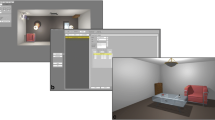Abstract
In recent years, visuospatial cognitive functions, which play a crucial role in human cognition, have sparked interest among psychologists and neuroscientists, focusing on assessment, training and restoration of these functions. Virtual reality, recognized as a modern technology, addressing the real-life aspects of visuospatial processing, provides an immersive environment that can be used for stimulation of cognitive functions and its effects that can be measured afterwards. In this paper, we describe an experimental design that involves cognitive testing and targeted, cognitively-oriented, stimulation in an immersive 3D virtual environment, rendered by a unique CAVE system. We focus primarily on a game, designed and developed to serve as the virtual environment. We also describe the experimental procedure that includes the measurement of an electrophysiological neural correlate of spatial working memory capacity – contralateral delay activity.
Access this chapter
Tax calculation will be finalised at checkout
Purchases are for personal use only
Similar content being viewed by others
References
de Bruin, N., Bryant, D., MacLean, J., Gonzalez, C.: Assessing visuospatial abilities in healthy aging: A novel visuomotor task. Front. Aging Neurosci. 8, 1–9 (2016)
Dijkstra, N., Zeidman, P., Ondobaka, S., Gerven, M.V., Friston, K.: Distinct top-down and bottom-up brain connectivity during visual perception and imagery. Sci. Rep. 7(1), 1–9 (2017)
Korečko, Š., Hudák, M., Sobota, B.: LIRKIS CAVE: architecture, performance and applications. Acta Polytech. Hung. 16(2), 199–218 (2019)
Korečko, Š., Hudák, M., Sobota, B., Marko, M., Cimrová, B., Farkaš, I., Rosipal, R.: Assessment and training of visuospatial cognitive functions in virtual reality: proposal and perspective. In: Proceedings of 9th IEEE International Conference on Cognitive Infocommunications (CogInfoCom), Budapest, pp. 39–43 (2018)
Kravitz, D., Saleem, K., Baker, C., Mishkin, M.: A new neural framework for visuospatial processing. Nat. Rev. Neurosci. 12(4), 217–230 (2011)
Luria, R., Balaban, H., Awh, E., Vogel, E.: The contralateral delay activity as a neural measure of visual working memory. Neurosci. Biobehav. Rev. 62, 100–108 (2016)
Matheis, R.J., Schultheis, M.T., Tiersky, L.A., DeLuca, J., Millis, S.R., Rizzo, A.: Is learning and memory different in a virtual environment? Clin. Neuropsychol. 21(1), 146–161 (2007)
Parsons, T.D., Carlew, A.R., Magtoto, J., Stonecipher, K.: The potential of function-led virtual environments for ecologically valid measures of executive function in experimental and clinical neuropsychology. Neuropsychol. Rehabil. 27(5), 777–807 (2017)
Paulus, W.: Transcranial electrical stimulation (tES - tDCS; tRNS, tACS) methods. Neuropsychol. Rehabil. 21(5), 602–617 (2011)
Schultheis, M.T., Himelstein, J., Rizzo, A.A.: Virtual reality and neuropsychology: upgrading the current tools. J. Head Trauma Rehabil. 17(5), 378–394 (2002)
Shipstead, Z., Harrison, T., Engle, R.: Working memory capacity and visual attention: top-down and bottom-up guidance. Q. J. Exp. Psychol. 65(3), 401–407 (2012)
Acknowledgements
This work has been supported by the APVV grant no. APVV-16-0202: “Enhancing cognition and motor rehabilitation using mixed reality”.
Author information
Authors and Affiliations
Corresponding author
Editor information
Editors and Affiliations
Rights and permissions
Copyright information
© 2020 Springer Nature Switzerland AG
About this paper
Cite this paper
Korečko, Š. et al. (2020). Experimental Procedure for Evaluation of Visuospatial Cognitive Functions Training in Virtual Reality. In: Hassanien, A., Shaalan, K., Tolba, M. (eds) Proceedings of the International Conference on Advanced Intelligent Systems and Informatics 2019. AISI 2019. Advances in Intelligent Systems and Computing, vol 1058. Springer, Cham. https://doi.org/10.1007/978-3-030-31129-2_59
Download citation
DOI: https://doi.org/10.1007/978-3-030-31129-2_59
Published:
Publisher Name: Springer, Cham
Print ISBN: 978-3-030-31128-5
Online ISBN: 978-3-030-31129-2
eBook Packages: Intelligent Technologies and RoboticsIntelligent Technologies and Robotics (R0)




